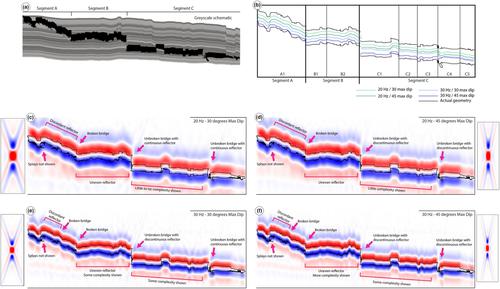当前位置:
X-MOL 学术
›
Basin Res.
›
论文详情
Our official English website, www.x-mol.net, welcomes your
feedback! (Note: you will need to create a separate account there.)
Lithological influence on sill geometry in sedimentary basins: Controls and recognition in reflection seismic data
Basin Research ( IF 2.8 ) Pub Date : 2024-02-29 , DOI: 10.1111/bre.12857 Martin Kjenes 1 , Christian Haug Eide 1 , Agustin Argüello Scotti 1 , Isabelle Lecomte 1 , Nick Schofield 2 , Anna Bøgh 3
Basin Research ( IF 2.8 ) Pub Date : 2024-02-29 , DOI: 10.1111/bre.12857 Martin Kjenes 1 , Christian Haug Eide 1 , Agustin Argüello Scotti 1 , Isabelle Lecomte 1 , Nick Schofield 2 , Anna Bøgh 3
Affiliation

|
Sills play a leading role in the transport of magma in sedimentary basins. The contact between sills and host rocks reflects the acting emplacement processes during sill propagation and evolution. Recent studies have shown that the propagation of sills and dykes is strongly influenced by the lithology of the host rocks, but none have detailed documentation of marginal features in large‐scale intrusive complexes. Three‐dimensional seismic data is the primary method of mapping and investigating such complexes, but it is difficult to accurately image sills due to their low thickness compared to seismic resolution. By understanding the relationship between local lithology and marginal sill features, we can better understand the imaging of sills in seismic datasets and their resulting geometry. In this study, we present a seismic‐scale sill analogue through multiple high‐resolution three‐dimensional models, with corresponding logs and field observations from Cedar Mountains, San Rafael Swell, US. This model was further used to develop a synthetic seismic dataset, providing us with a strong control on which marginal sill features fall beneath seismic resolution. We found that lithology plays a critical control in sill geometry and morphology. In Cedar Mountains, sills emplaced within massive sandstones frequently exhibit strata‐discordant base contact with the host rock. Conversely, sills found within heterolithic intervals and mudstones typically display strata‐concordant base contact with the host rocks. Sills within heterolithic intervals also tend to exhibit a more complex segmentation with multiple broken bridges. Furthermore, our findings show that sills are more than 3.7 times more likely to intrude in mudstone compared to sandstone and heterolithic intervals. These results suggest how sill geometries can be adapted to interpret lithology in seismic datasets from sedimentary basins with little to no well control. We anticipate that our findings may provide better knowledge for interpreting sills in sedimentary basins and contribute to developing more sophisticated geomechanical emplacement models for igneous intrusions.
中文翻译:

岩性对沉积盆地基岩几何形状的影响:反射地震数据的控制和识别
岩床在沉积盆地中的岩浆输送中起主导作用。岩床与围岩之间的接触反映了岩床传播和演化过程中的作用侵位过程。最近的研究表明,岩床和岩脉的扩展受到主岩岩性的强烈影响,但没有关于大规模侵入杂岩边缘特征的详细记录。三维地震数据是绘制和研究此类复合体的主要方法,但由于其厚度低于地震分辨率,因此很难准确地成像。通过了解局部岩性和边缘基台特征之间的关系,我们可以更好地理解地震数据集中的基台成像及其产生的几何形状。在这项研究中,我们通过多个高分辨率三维模型,以及来自美国圣拉斐尔斯韦尔雪松山的相应测井和现场观测,提出了地震尺度的基台模拟。该模型进一步用于开发合成地震数据集,为我们提供了对哪些边缘窗台特征低于地震分辨率的强有力的控制。我们发现岩性对基台几何形状和形态起着关键的控制作用。在雪松山脉,位于大块砂岩内的岩台经常表现出与主岩不和谐的地层接触。相反,在异石器层段和泥岩中发现的基台通常表现出与主岩一致的地层接触。异石器间隔内的窗台也往往表现出更复杂的分割,有多个断桥。此外,我们的研究结果表明,与砂岩和异岩层段相比,岩床侵入泥岩的可能性高出 3.7 倍以上。这些结果表明如何调整基台几何形状来解释来自沉积盆地的地震数据集中的岩性,几乎没有井控制。我们预计我们的研究结果可能会为解释沉积盆地的基台提供更好的知识,并有助于开发更复杂的火成岩侵入地质力学就位模型。
更新日期:2024-02-29
中文翻译:

岩性对沉积盆地基岩几何形状的影响:反射地震数据的控制和识别
岩床在沉积盆地中的岩浆输送中起主导作用。岩床与围岩之间的接触反映了岩床传播和演化过程中的作用侵位过程。最近的研究表明,岩床和岩脉的扩展受到主岩岩性的强烈影响,但没有关于大规模侵入杂岩边缘特征的详细记录。三维地震数据是绘制和研究此类复合体的主要方法,但由于其厚度低于地震分辨率,因此很难准确地成像。通过了解局部岩性和边缘基台特征之间的关系,我们可以更好地理解地震数据集中的基台成像及其产生的几何形状。在这项研究中,我们通过多个高分辨率三维模型,以及来自美国圣拉斐尔斯韦尔雪松山的相应测井和现场观测,提出了地震尺度的基台模拟。该模型进一步用于开发合成地震数据集,为我们提供了对哪些边缘窗台特征低于地震分辨率的强有力的控制。我们发现岩性对基台几何形状和形态起着关键的控制作用。在雪松山脉,位于大块砂岩内的岩台经常表现出与主岩不和谐的地层接触。相反,在异石器层段和泥岩中发现的基台通常表现出与主岩一致的地层接触。异石器间隔内的窗台也往往表现出更复杂的分割,有多个断桥。此外,我们的研究结果表明,与砂岩和异岩层段相比,岩床侵入泥岩的可能性高出 3.7 倍以上。这些结果表明如何调整基台几何形状来解释来自沉积盆地的地震数据集中的岩性,几乎没有井控制。我们预计我们的研究结果可能会为解释沉积盆地的基台提供更好的知识,并有助于开发更复杂的火成岩侵入地质力学就位模型。

































 京公网安备 11010802027423号
京公网安备 11010802027423号